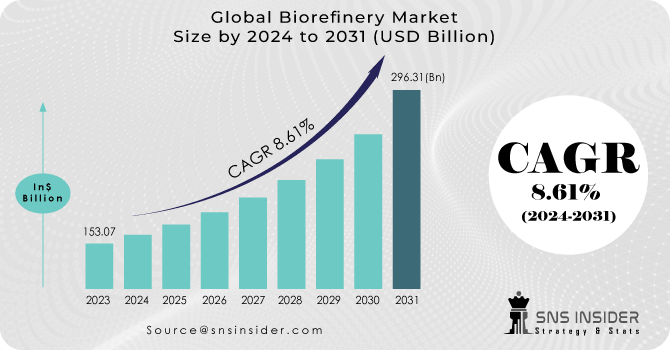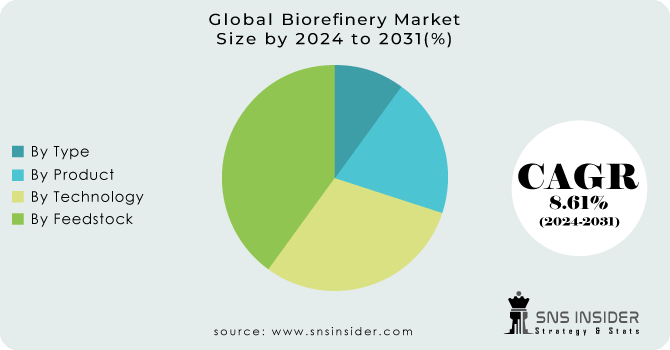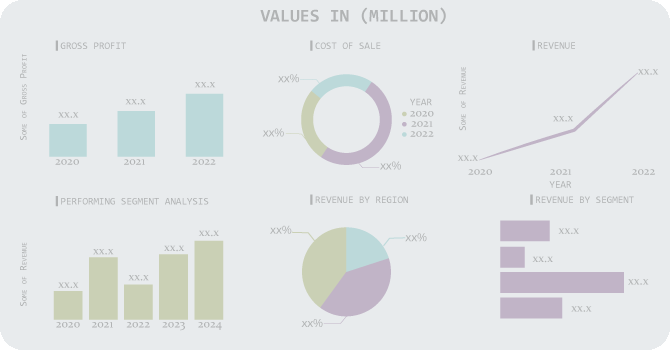Biorefinery Market Report Scope & Overview:
The Biorefinery Market size was valued at USD 153.07 billion in 2023 and is expected to grow to USD 296.31 billion by 2031 and grow at a CAGR of 8.61% over the forecast period of 2024-2031.
Biorefinery is the sustainable processing facility or network of facilities that involve the conversion of biomass into value-added products such as transportation biofuels, biopower, biochemicals, and other biomaterials. This sustainable process facility converts biomass into new green, clean, and environment-friendly products. Raw materials used for the biorefinery process come only from renewable sources. But biorefinery is a complex and slow conversion process that has high recovery costs. This type of process also has technical limitations and a low adoption rate.

Get More Information on Semiconductor Chip Market - Request Sample Report
Biorefinery processes promote the use of biofuels and biomaterials instead of fossil fuels which helps to limit greenhouse gas emissions and protect the climate from the hazardous effects of carbon footprint. Biorefinery is a very attractive process for the conversion of waste biomass into valuable products.
Impact of COVID-19
The global biorefinery market witnessed a severe drop in production due to the COVID-19 pandemic. According to the International Energy Agency (IEA), the reduced fuel demand with stringent lockdown restrictions drops the production rate of biofuel by about 11.7%. During the Covid-19 pandemic, World Bioenergy Association witnessed the reduced or even termination of new investment in the bioenergy sector due to the uncertainty in the situation which delay the decision about new investment and ultimately affected the biorefinery process. The visible reduction in demand for transportation fuel due to the strict lockdown the use of biofuels also decreased which impacted the biorefinery market severely.
Market Dynamics
Drivers
-
Emerging use of biomass for a variety of applications
-
Rising demand for clean and renewable energy sources
-
Increasing adoption of greener technologies
-
Increasing consumption of energy due to rapid industrialization
-
Increasing awareness regarding reducing greenhouse gas emission
To curb the carbon footprint use of fossil fuels should be reduced and the use of renewable energy sources should be increased. The government is taking the initiative to invest in clean fuels which increases the adoption of greener technologies. Nowadays biomass is used widely in various sectors to fulfill the energy, chemical, and power demand. All these factors support the growth of the biorefinery market significantly.
Restrain
-
Stringent restriction on selecting feedstock type
Opportunities
-
Rapid advancement in biorefinery technologies
-
Increase in the investment by the government in cleaner fuel
Challenges
-
Fluctuating feedstock prices
The high cost of biomass and volatile feedstock prices hampers the biorefinery market growth significantly. The cost of feedstock decides the cost of final biofuels and other biomaterials. For the high production capacity, consistent quality of feedstock is required. Biomass needed to be stored before being sent to the biorefinery processes. So, to keep biomass as it is the feedstock quality should be great. All these factors led to an increase in the price of feedstock which further challenges the biorefinery market.
Impact of Russia-Ukraine War:
The ongoing conflict between Russia and Ukraine has had a significant impact on various industries, including the biorefinery market. The war has disrupted the supply chain of biomass, which has affected the production and profitability of biorefineries. The biorefinery market is highly dependent on the availability and cost of biomass feedstocks, such as agricultural residues, forestry residues, and energy crops.
Ukraine is one of the largest producers of biomass in Europe, and its conflict with Russia has disrupted the supply of biomass to biorefineries in the region. The transportation of biomass has become more difficult and expensive due to the conflict, which has led to a shortage of feedstocks and increased prices. Furthermore, the war has also affected the investment climate in the region. The political instability and economic uncertainty have made it difficult for biorefinery companies to secure funding for their projects. Investors are hesitant to invest in the region due to the risk of political and economic instability, which has slowed down the growth of the biorefinery market.
Impact of Recession:
The biorefinery market has been significantly affected by the recent economic recession. The downturn in the global economy has led to a decrease in demand for biofuels and other biorefinery products. This has resulted in a decline in the profitability of biorefinery companies and a slowdown in the growth of the industry. Despite these challenges, there are still opportunities for the biorefinery market to thrive in the current economic climate. One of the key factors that will determine the success of biorefinery companies is government support for the biorefinery industry. Many countries have implemented policies and incentives to encourage the development of renewable energy sources, including biofuels. These initiatives can help to stimulate demand for biorefinery products and create a more favorable business environment for companies in the industry.
Key Market Segmentation
By Product
-
Energy
-
Chemical
-
Material
-
Others
By Type
-
First Generation
-
Second Generation
-
Third Generation.
By Technology
-
Industrial Biotechnology
-
Physicochemical
-
Biochemical
-
Thermochemical
By Feedstock
-
Starch & Sugar Crops
-
Energy Crops
-
Organic & Agricultural Residues
-
Multifeedstock
-
others

Get Customised Report as per Your Business Requirement - Enquiry Now
Regional Analysis
Asia Pacific is the dominant region for the biorefinery market. The reason for this dominance is that China has imposed a policy that promotes the production and usage of biofuels rather than fossil fuels. Increasing demand for electricity from the commercial and residential sectors, rising environmental concerns, increasing population, rising disposable income, increasing adoption of clean and renewable energy, and increasing number of biobased refineries are some other factors that drive the biorefinery market in the Asia Pacific region.
Europe is the second largest market and is expected to show significant growth during the forecast period. In 2021 Germany dominated in Europe region. In 2020 Germany developed a new German bio-economy strategy which helped to strengthen Germany as a bioeconomy leader. The growing popularity of biobased product to reduce greenhouse gas emission drive the biorefinery market in this region.
REGIONAL COVERAGE:
-
North America
-
USA
-
Canada
-
Mexico
-
-
Europe
-
Germany
-
UK
-
France
-
Italy
-
Spain
-
The Netherlands
-
Rest of Europe
-
-
Asia-Pacific
-
Japan
-
south Korea
-
China
-
India
-
Australia
-
Rest of Asia-Pacific
-
-
The Middle East & Africa
-
Israel
-
UAE
-
South Africa
-
Rest of the Middle East & Africa
-
-
Latin America
-
Brazil
-
Argentina
-
Rest of Latin America
-
Key Players
The major players are Valero, Renewable Energy Group, Neste, Total Energies, Vivergo Fuel, Borregard AS, Wilmar International Ltd., Godavari Biorefineries, Sekab, Cargill Inc., Honeywell International Inc., Abengoa, Clariant, Green Plains, and other players
Neste Company- Financial Analysis

| Report Attributes | Details |
| Market Size in 2023 | US$ 153.07 Bn |
| Market Size by 2031 | US$ 296.31 Bn |
| CAGR | CAGR of 8.61% From 2024 to 2031 |
| Base Year | 2023 |
| Forecast Period | 2024-2031 |
| Historical Data | 2020-2022 |
| Report Scope & Coverage | Market Size, Segments Analysis, Competitive Landscape, Regional Analysis, DROC & SWOT Analysis, Forecast Outlook |
| Key Segments | • By Product (Energy, Chemical, Material, and Others) • By Type (First Generation, Second Generation, and Third Generation) • By Technology (Industrial Biotechnology, physicochemical, Biochemical, and Thermochemical) • By Feedstock (Starch & Sugar Crops, Energy Crops, Organic & Agricultural Residues, Multifeedstock, and others) |
| Regional Analysis/Coverage | North America (USA, Canada, Mexico), Europe (Germany, UK, France, Italy, Spain, Netherlands, Rest of Europe), Asia-Pacific (Japan, South Korea, China, India, Australia, Rest of Asia-Pacific), The Middle East & Africa (Israel, UAE, South Africa, Rest of Middle East & Africa), Latin America (Brazil, Argentina, Rest of Latin America) |
| Company Profiles | Valero, Renewable Energy Group, Neste, Total Energies, Vivergo Fuel, Borregard AS, Wilmar International Ltd., Godavari Biorefineries, Sekab, Cargill Inc., Honeywell International Inc., Abengoa, Clariant, Green Plains, and other |
| Key Drivers | • Emerging use of biomass for a variety of applications • Rising demand for clean and renewable sources of energy |
| Market Opportunities | • Rapid advancement in biorefinery technologies • Increase in the investment by the government in cleaner fuel |

